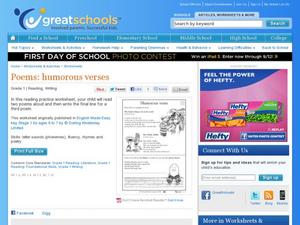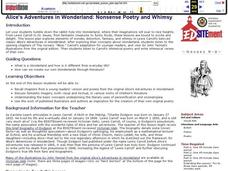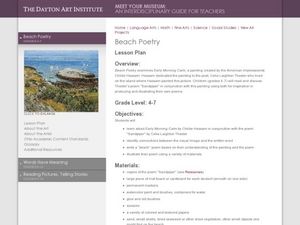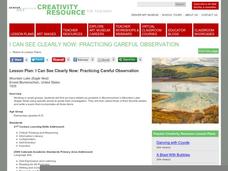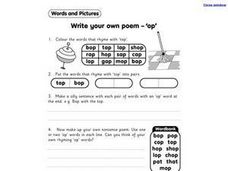Curated OER
Poems: Humourous Verses
First grade is a great time to build strong reading skills. Here are three short rhyming poems or common nursery rhymes that are intended to help boost reading fluency. Because most children know these rhymes, they will have an easier...
National Endowment for the Humanities
The World of Haiku
Students complete a study of Japanese culture through haiku. They read and interpret haiku poetry and write haiku of their own.
Curated OER
Alice's Adventures in Wonderland: Nonsense Poetry and Whimsy
Primary learners are introduced to Lewis Carroll's whimsical poetry. They read "The Nursery Alice" Carroll's adaptation for younger readers, view story illustrations, listen to poetry and write whimsical verses of their own about food.
University of North Carolina
Literature (Fiction)
An informative installment of the Writing for Specific Fields series helps readers learn how to interpret and write about fiction. The website details nine easy steps for writing a literary analysis—a useful method for all readers!
Curated OER
Lesson: Unfolding Water Lilies
Comparing two different artistic mediums can be a welcome challenge. Learners compare Monet's The Water Lily Pond to three nature-inspired poems. They consider how each art form is interrelated, descriptive, and expressive. They then...
Curated OER
Beach Poetry
Familiarize young analysts with the relationship between words, meaning, and visual images. They consider the relationship between the painting Beach Poetry and the poem Sandpaper. They compose and illustrate an original a beach poem...
Curated OER
Pictures in Words: Poems of Tennyson and Noyes
Learners examine how Tennyson and Noyes use words to paint vivid pictures. They read and analyze two poems, complete an online scavenger hunt, complete a worksheet, and write examples of alliteration, personification, metaphor, simile,...
Curated OER
The Study of Theme and Figurative Language in Poetry and/or Prose
Identify and analyze the use of figurative language used in select pieces of writing. These pieces of literature will represent at least two pieces by one writer and at least two pieces by different writers. This lesson plan would be a...
Curated OER
Lesson: Creating With A Purpose
Discovering the creative process can be done through critical analysis. Upper graders examine a hand -carved Shinto Deity, discussing purpose, technique, and artistic expression. They then read a poem about the creative process. and...
Curated OER
Lesson: That Long Jakes
Cross-media analysis takes time and attention to detail. The class analyzes the painting Long Jakes and the poem "Backward Bill." They pay attention to the similarities and differences in each piece, looking for details that describe the...
Southern Nevada Regional Professional Development Program
Reading Literature - The Ruin
Cross-comparison, the technique of focusing on two different texts with the same themes, motifs, events, etc., is employed in an exercise that asks groups to examine two different translations of “The Ruin,” a poem, written in Old...
Curated OER
Lesson: I Can See Clearly Now Practicing Careful Observation
Poetry and art analysis go hand-in-hand. In groups, youngsters analyze a landscape painting, making careful observations. They use details found in the painting to inspire an original poem. The poem must include at least three objects...
Curated OER
Life Reflections in Songwriting and Poetry
Students analyze, discuss and compare sources of inspiration, use of words and imagery, and other differences in writing styles between two featured songwriters. This is an introductory lesson to a creative project unit.
Curated OER
Lesson: Expressing the Inner Life of Things
Found metal objects were welded together to create an inspiring African sculpture. Learners consider the use of objects and the inspiration of African art seen in Picasso's work. They then find and create a scrap art sculpture, as well...
Curated OER
Lesson: One of These Things is Not Like the Other
Kids kick of the lesson plan by comparing and contrasting the focus painting to other similar paintings of Native American women. They then compare their own personal portraits (photographs) in a similar way. They use the differences in...
Curated OER
Lesson: Living For The City
Both Money and Cummings were able to capture the essence of Paris. Critical thinkers analyze how each artist used his medium to describe the same place in a different way. Kids then write a Cummings-style poem about Monet's Waterloo Bridge.
Scholastic
The Midnight Ride of Paul Revere
Practice sequencing events using Henry Wadsworth Longfellow's narrative poem about the famous revolutionary hero. Learners read Revere's own account of the event, and compare/contrast the two texts using a t-chart. Finally, they imagine...
Curated OER
Poems: Itsy Bitsy Spider
Act out the "Itsy Bitsy Spider" rhyme with youngsters. Learners observe visual instructions before completing the corresponding actions, then draw the spider into a scene. Finally, they write down rhyming words that have the ai spelling...
Curated OER
Quirky Quatrain Poetry Lesson
Middle schoolers discover what a quatrain is, and are taught the three poetic devices: alliteration, hyperbole, and onomatopoeia. Everyone chooses a favorite hobby or activity, then attempts to write a poem about it. They must write two...
Curated OER
What are the Elements of Poetry
Students read the poem "Ode to Pablo's Tennis Shoes" and analyze the form, figurative language, and mood. They complete a T-chart containing what they have learned about Pablo and the evidence from the poem supporting their conclusions.
Curated OER
Write You Own Poem 'et'
In this rhyming words worksheet, students complete four exercises that help them use rhyming words to first write a silly sentence and then write a poem. Students use the words pet, wet, set, let, net, bet, vet, met, get, and jet.
Curated OER
Write Your Own Poem 'en'
In this rhyming words instructional activity, students complete four exercises that help them use rhyming words to first write a silly sentence and then write a poem. Students use the words Ben, den, fen, hen, Len, men, pen, ten, and then.
Curated OER
Write Your Own Poem 'in'
For this rhyming words worksheet, students complete four exercises that help them use rhyming words to first write a silly sentence and then write a poem. Students use the words bin, win, fin, din, pin, sin, tin, shin, thin, and chin.
Curated OER
Write Your Own Poem 'op'
In this rhyming words activity, learners complete four activities that help them use rhyming words using a consonant-vowel-consonant pattern. Students complete a word find, pair the words that rhyme, and use the words in a silly sentence...
Other popular searches
- Writing Poetry Onomatopoeia
- Writing Poetry Third Grade
- Writing Poetry and Prose
- Creative Writing Poetry
- Writing Poetry Rhyming Poems
- Descriptive Writing/poetry
- Writing Poetry Unit
- Writing Poetry Lesson Plans
- Poetry Writing Workshop
- Writing Concrete Poetry
- Writing Poetry On
- Teaching Poetry Writing


